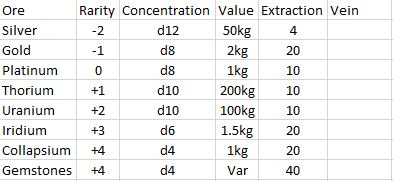Future Imperfect - Mining
Let's face it, you need to make a living. Mining may not be as flashy and exciting as being a mercenary, but it does offer many advantages to the part time adventurer. First and foremost, searching the vast openness of space for minerals can be a great adventure hook! Miners also have a great deal of freedom, which is a hallmark of adventurers in fiction. It also has the chance to be very lucrative under the appropriate circumstances. As with many other facets of Future Imperfect, these systems could be handled with a simple binary die roll, or even a linked series of checks. But for those of you who crave more depth and detail to their game, the mining and prospecting minigame should provide the proverbial mother lode your crew is so diligently seeking.
Contents
Prospecting
Before any mining can take place, an appropriate segment of space must be identified. Prospecting can be done either planetside, on hostile or otherwise uninhabited planets, or in asteroid clusters (or other collections of space debris). The vast majority of material in space will be the most common elements: iron, aluminum and the like. Given the expense of the expedition, refining and organizing the mission, it would not be cost-effective to engage on such finds. Therefore, much of the prospecting is done from the ship, operating powerful sensor software that can locate potential rich sources of valuable material.
Mining is a multi-step process, from prospecting, to identifying deposits, to mining, then refining the ore and finally selling it. Each step is vital to realizing profits for the involved parties. As with other systems within Future Imperfect, results can be obtained in a small number of cards, but the action is divided up into discrete portions to encourage encounters and roleplaying.
Software
Any starship sensors can be used to search for specific metals or mineral deposits. This is extremely inefficient, and labor intensive, however. The area scanned is one cubic light second of volume per MK of the ship's computer per month. A sensor officer must be present to perform the scanning, so the ship may not be able to perform other functions requiring full use of the sensors during this time. The sensor officer may attempt to double the area with a standard (5) sensors test, quadruple it on a difficult (7) test, or multiply it by eight with a challenging (9) test. This test is modified by the rarity of the mineral being sought. The master should draw the appropriate cards, and to ensure the crew is kept in suspense, three cards should be drawn each time (the second two are only used in the event of increased effect). Even in the best case scenario, it would take months to properly scan an area of any size.
Specialized mining software is available, and comes in quality ranging from MK I-X. Mining software can look for a number of specific materials equal to 2 times the MK value simultaneously. Additional materials may be added by increasing any difficulties by +1 per. Mining software does not require constant attention from a sensor officer, but will need to be checked occasionally, either by a crew member or a ship's computer subroutine. Sensors can gather vast amounts of data and organize it well, the mining software presents it in a way that is easily analyzed by a trained technician. Assisted by the appropriate software, a mining technician can analyze 10 cubic light seconds of volume per MK of the software, per day. Identifying potential lodes within the scanned area is a standard (5) Trade: Miner check. As above, the Master should draw the cards (three per check) and relay the results. One potential lode is located per success and bump.
No matter whether mining software is used or not, deposits are checked for each 10 cubic light seconds of space surveyed.
False Deposits
Not all potential deposits are viable lodes. Sometimes there is only a small amount of the requested substance, sometimes it is not pure enough to be viable, and other times the software is just plain wrong. Consult the step value of the card. This is the total number of potential lodes noted by the analysis. The number of actual lodes is determined by the success and bumps generated.
Each deposit will need to be inspected more closely to determine its efficacy. Inspecting a deposit requires 8 (man x skill) hours, and must be done from the surface (or very close). Only skilled crew members or automatons count in the calculation. For example, a level 2 Trade: Miner crew member and a MK II mining Mek will take two hours to inspect a potential deposit to determine whether or not it is viable. If they brought along two unskilled crew mates, the time required would be unchanged.
In the event of a critical failure, use the fragment to determine a number of the false deposits that will initially seem to be viable. After a number of excavation hours equal to the impulse of the card the error can be determined.
Lode Magnitude
The effect level will determine the quality and magnitude of the deposit. Use the given column (based on the material type) and row (miner skill) to find the richness. The Master should notate these values when making the checks (jot down the card number, or write the numbers).
Claim Beacons
Registering a claim is both a risk and highly advantageous, depending on the circumstances.
Mining
Refining
Selling Ore and Metal
Types of Ore
The following materials are considered valuable enough for deep space prospecting. Because of the rarity of many minerals, it is often not possible to entirely fill the holds of larger vessels, this is why in many cases smaller and less expensive ships are often more viable as deep space mining operations.
